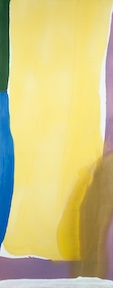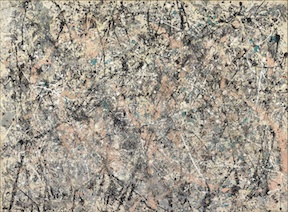
Helen Frankenthaler (American, 1928–2011), Wales, 1966. Acrylic on canvas, 113 3/16 x 45 1/16 in. (287.5 x 114.4 cm). National Gallery of Art, Washington, D.C. Anonymous Gift, 1981.86.1 © 2014 Helen Frankenthaler Foundation, Inc. / Artists Rights Society (ARS), New York
(WILLIAMSTOWN, Mass.) – Roll over, Renoir, and give Monet the news – for the first time in its history, the Clark Art Institute will feature abstract paintings by the likes of Jackson Pollock, Mark Rothko, Helen Frankenthaler, Ellsworth Kelly and Jasper Johns, in Make It New: Abstract Painting from the National Gallery of Art, 1950–1975, opening Saturday, August 2. 2014, and running through Monday, October 13, 2014.
The exhibition examines the different paths taken by abstract painters in the first quarter-century of the postwar period. Masterworks such as Jackson Pollock’s Number 1, 1950 (Lavender Mist), Mark Rothko’s No. 1 (1961), and Lee Bontecou’s Untitled (1962) reveal how artists in America and Europe experimented with color, geometry, and material to expand the definition of painting.
Make It New showcases Jackson Pollock’s Lavender Mist, one of a handful of large works the artist made in mid-1950 in a converted barn in Springs, Long Island, at the height of his creative powers. This seminal work of abstraction is regarded as the point of departure — at once highlighting the apex of Pollock’s signature iconography and posing the question: But what of the next generation? Was Pollock a great liberator for them, or did he become another Picasso, a figure of authority to be emulated or challenged?
The exhibition considers the relationship between influence and originality, tracing how these artists responded to the challenge that Pollock’s mature style posed to prevailing notions of painting. Visitors will encounter five rooms, cutting across geographies and narrow timeframes. Make It New presents works within two historical contexts — Abstract Expressionism and color field — alongside canonical works organized by formal categories of pattern, texture, and shape. The exhibition is curated by Harry Cooper, curator of Modern Art, National Gallery of Art, Washington, D.C., with David Breslin, associate director of the Research and Academic Program and associate curator of contemporary projects at the Clark.

Ellsworth Kelly (American, born 1923), Tiger, 1953. Oil on canvas (five joined panels), 80 3/4 x 85 1/2 in. (205.1 x 217.2 cm). National Gallery of Art, Washington, D.C. Gift of the Artist, 1992.85.1
© Ellsworth Kelly
“At the heart of our campus expansion was a desire to not only broaden our physical space but also to demonstrate the depth and breadth of art scholarship at the Clark,” said director Michael Conforti. “Make It New breaks ground, offering visitors the opportunity to look closely at a single period in art history and to connect with modern art in exciting ways. The works also evocatively engage with Ando’s modernist architecture, bringing additional depth to the impact of these works.”
The title of the exhibition comes from Ezra Pound’s modernist exhortation: ‘make it new.’ Cooper said, “Ezra Pound’s ambiguous motto is appropriate for an exhibition of paintings that, at the time of their making, were at once traditional and radical, mindful of authority yet bursting with authorship.”
The installation in Ando’s expansive galleries will make it possible for visitors to see and consider multiple, contrasting works from a single vantage point, facilitating reflection on alternative narratives of postwar art. Pollock’s Number 1, 1950 (Lavender Mist) will be paired with Rothko’s No. 1, suggesting the formal variety of practices gathered under the banner of Abstract Expressionism. In the ‘Shape’ gallery, Target (1958) by Jasper Johns will be placed next to Richard Tuttle’s White Cotton Octagonal (1971), a piece of cut cloth whose very attachment to the wall compels visitors to see it as a painting, permitting the viewer to look closely and think across established categories. The ‘Color Field’ gallery will include works by Helen Frankenthaler and Morris Louis; ‘Pattern’ features works by Cy Twombly, Alma Thomas, and Marcel Broodthaers; and ‘Texture’ includes paintings by Robert Ryman, Jean Fautrier, and Lee Bontecou.

Jackson Pollock (American, 1912–1956), Number 1, 1950 (Lavender Mist), 1950. Oil, enamel, and aluminum on canvas, 87 x 118 in. (221 x 299.7 cm). National Gallery of Art, Washington, D.C. Ailsa Mellon Bruce Fund, 1976.37.1 © 2014 The Pollock-Krasner Foundation / Artists Rights Society (ARS), New York
Make It New is accompanied by a fully illustrated catalogue published by the Clark and distributed by Yale University Press. The publication includes a major scholarly essay by Harry Cooper and entries by the Clark’s David Breslin, associate director of the Research and Academic Program and associate curator for contemporary projects, and Matt Jolly, Ph.D. candidate in the History of Art and Architecture, Harvard University.
This exhibition is organized by the National Gallery of Art, Washington, in collaboration with the Clark Art Institute.
The Clark Art Institute is one of a small number of institutions globally that is both an art museum and a center for research, critical discussion, and higher education in the visual arts. Opened in 1955, the Clark houses exceptional European and American paintings and sculpture, extensive collections of master prints and drawings, English silver, and early photography. Acting as convener through its Research and Academic Program, the Clark gathers an international community of scholars to participate in a lively program of conferences, colloquia, and workshops on topics of vital importance to the visual arts. The Clark library, open to the public with more than 240,000 volumes, is one of the nation’s premier art history libraries. The Clark also houses and co-sponsors the Williams College Graduate Program in the History of Art.
The Clark opened its expanded facilities on July 4, 2014, unveiling new and enhanced spaces that accommodate the continued growth of the Institute’s programs. Included in this final stage of the project are a new 42,600-square-foot Clark Center designed by Tadao Ando Architect & Associates, expansion and renovation of the original Museum Building and the ongoing renovation of the Manton Research Center by Selldorf Architects, and a sweeping redesign of the grounds by Reed Hilderbrand. The first phase of the campus expansion project was completed in 2008 with the opening of the Lunder Center at Stone Hill, a striking conservation and exhibitions facility also designed by Tadao Ando.
The Clark is located at 225 South Street in Williamstown, Massachusetts. Opening season hours: Galleries open daily from July 4 through October 13, 2014, 10 am to 5 pm (Fridays in July and August until 7 pm). From October 14, 2014 through June 30, 2015: Galleries open Tuesday through Sunday, 10 am to 5 pm. Admission is $20 through October 31, 2014 and free year-round for Clark members, children 18 and younger, and students with valid ID. For more information, visit Clark Art Institute or call 413 458 2303.
